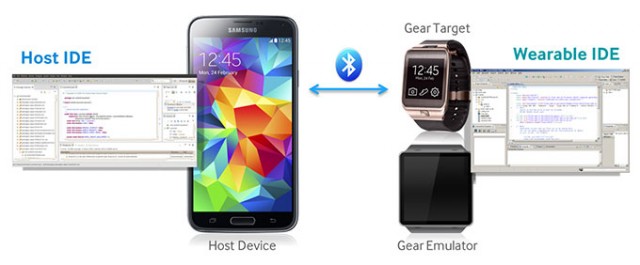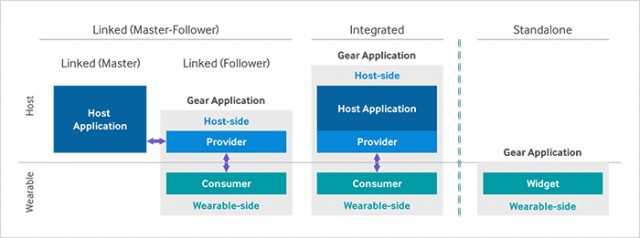
Google's wearables SDK is supposed to launch sometime next week, and it will mark the launch of a new Android-based platform that Google hopes will take over the wearables market the way that Android captured the smartphone market. The difference this time is that Google won't have the biggest Android OEM in its corner: Samsung is going out on its own.
Well, the company is at least dipping its toe in the "going out on its own" pool. Today Samsung is launching an SDK of its very own (first spotted by Engadget) for the new Tizen-powered Gear smartwatches. The Samsung Gear is the sequel to the company's disappointing Galaxy Gear smartwatch, and with the new hardware (actually three new pieces of hardware), Samsung has switched from Android to the Samsung-made Tizen OS. Samsung's rise to power in the mobile industry has been entirely fueled by Android-powered devices, but now the company feels it is big enough to try its hand at ground-up OS and ecosystem building.Apps for the original Galaxy Gear were hard to come by. While there were some third-party apps, the SDK was only available to developers approved by Samsung. The awkwardly named "Tizen SDK for Wearable" is a public release, though, allowing anyone to make a Gear app. The Gear will need apps, too, because thanks to the switch to Tizen, the app pool is starting over from scratch.

Just like the original Gear, these new versions receive an Internet connection from a Bluetooth-tethered Samsung Android phone running the Gear companion app. Samsung's SDK allows for three types of Gear applications. There's "Linked (Master-Follower)," which plugs into an Android app that is shipped separately from the wearable app, "Integrated" which is an Android phone app and Tizen watch app packaged together, and a "Standalone" app which doesn't require a host smartphone app. (Standalone apps are limited to things like watch faces, since they won't be able to access the Internet). Gear apps use Tizen's "Web runtime," HTML5 apps that run outside a browser. Messages are passed back and forth between the Gear app and the Android companion app through the Samsung Accessory Protocol, which provides things like remote control of music and volume, notification relay, and file transfers.
Having an SDK and your own OS also means that you need to have an app store with a submission process. Samsung is handling distribution through a store inside the Gear Manager app, and app submissions are handled though the "Samsung Apps Seller Office" (which doesn't seem to work as of press time). The final line of the app submission process states, "App distribution will be completed after reviewing your app," which makes it sound like Samsung is going the Apple route and having a person review every app submission.
Of the three Gear devices, the SDK seems limited to the Gear 2 and Gear 2 Neo—the square versions of the Samsung's smartwatch. The more interesting model is the Gear Fit, which uses a curved AMOLED screen in a bracelet-style form factor. While the Gear 2 and Gear 2 Neo have the same screen size and therefore could run the same apps, the Gear Fit is a completely different form factor and would need specialized apps.
After seeing the low sales of the original Galaxy Gear, the soon-to-come OEM-agnostic wearable SDK from Google, and Samsung's decision to suddenly shift from Android to Tizen, will anyone build a Tizen app for the Gear? Samsung is in the business of moving hardware, and there's nothing stopping Samsung from selling an Android-based device, too. Tizen will be an uphill battle for Samsung with no benefit other than "differentiation" from all the other Android OEMs, but Samsung starts with a big differentiator: scale. No other Android OEM seems capable of something like a simultaneous worldwide launch across carriers, and that is a massive advantage. But the switch to Tizen is also adding an additional burden to Gear developers. The Gear apps use Tizen, and the companion apps use Android, so now developers have to learn and constantly deal with two operating systems for a single Gear project.
If you're interested in checking out the Tizen wearable SDK, the documentation is here. The SDK, which supports Windows, Mac OS, and Linux, can be grabbed from this link.
reader comments
12